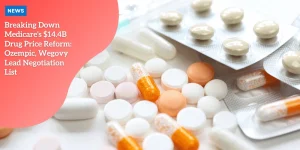Breaking: Novo Nordisk to Discuss Lowering Ozempic and Wegovy Prices
Novo Nordisk CEO’s Testimony
Novo Nordisk CEO Lars Fruergaard Jørgensen took the stand before the Senate committee amidst heightened scrutiny over the high prices of Ozempic and Wegovy.
Anúncios
Sen. Bernie Sanders was quick to challenge Jørgensen, honing in on the staggering disparity between U.S. and international drug prices.
Americans fork out roughly $1,349 a month for Wegovy, while counterparts in Germany and the UK pay between $92 to $140.
High Prices Justified?
Jørgensen defended the pricing structure, asserting that higher list prices are crucial for ensuring broader access.
Anúncios
He claimed that pharmacy benefits managers (PBMs) would drop these drugs from their formularies if prices were lowered.
It was a contentious point, especially in light of the economic burden posed by diabetes and obesity in the U.S., costing the nation billions annually.
Sanders’ Counterpoint
Sen. Sanders didn’t hold back, presenting commitments from major PBMs like Optum Rx, CVS Health’s Caremark, and Cigna’s Express Scripts.
Anúncios
According to Sanders, these PBMs pledged that they wouldn’t remove drugs from their formularies if prices were reduced.
This undercut Jørgensen’s argument and pushed him to agree to meet with PBMs and the Senate committee to discuss lowering prices.
Price Disparities and Practices
The hearing also spotlighted the immense price gap between the U.S. and other countries, probing deeper into pharmaceutical industry practices.
The discussion took aim at the role of PBMs in perpetuating high drug prices through rebates and discounts.
Critics argued that PBMs, despite being extremely profitable, contribute nothing to life-saving innovations.
This Senate hearing sets the stage for more intense debates on health care costs, with substantial implications for the pharmaceutical industry and PBMs, moving discussions toward balancing profit motives and patient access.
CEO’s Initial Defense of Pricing
Ensuring Broader Access Through High Prices
During the Senate hearing, Novo Nordisk CEO Lars Fruergaard Jørgensen defended the high prices of Ozempic and Wegovy by positing that these elevated list prices are crucial in ensuring broader access to these life-saving medications.
Jørgensen argued that the economic burdens tied to Type 2 diabetes and obesity—amounting to $413 billion and $1.7 trillion, respectively—necessitate robust financial strategies to secure comprehensive insurance coverage for these conditions.
PBMs and Formulary Inclusion
Jørgensen also emphasized that Pharmacy Benefit Managers (PBMs) play a pivotal role in determining drug inclusion on formularies, asserting that lower prices might lead to these drugs being excluded.
“For every dollar Novo Nordisk makes, it gives 74 cents to PBMs and insurance companies,” Jørgensen stated, illuminating the financial dynamics that pressure the company to set high list prices.
Economic Impact of Diabetes and Obesity
Further, Jørgensen highlighted the staggering economic impacts of diabetes and obesity on the U.S. healthcare system.
He noted that these chronic conditions not only cost billions of dollars but also cause significant physical and emotional tolls on patients.
Thus, maintaining high prices is framed as a mechanism to support ongoing treatment innovations and insurance coverage, which ultimately, according to Jørgensen, benefits the patients in the long run.
Moving forward, the discourse shifts towards examining the commitments from PBMs and their substantial influence on drug pricing and access.
PBMs’ Role in Drug Pricing
PBMs Commit to Maintain Drug Access
During the Senate hearing, Sen. Bernie Sanders presented commitments from major PBMs, including UnitedHealth Group’s Optum Rx, CVS Health’s Caremark, and Cigna’s Express Scripts.
These PBMs have agreed in writing that if Novo Nordisk lowers the list prices of Ozempic and Wegovy, they will not remove the drugs from their formularies.
This is a key point since formulary inclusion is crucial for patient access.
Influence of PBMs on Pricing and Access
PBMs play a significant role in the pricing and accessibility of prescription drugs.
They work as intermediaries between drug manufacturers and insurance companies, negotiating discounts and rebates to secure formulary placement for medications.
However, they have also been criticized for driving up drug prices.
For every dollar made by Novo Nordisk, 74 cents go to PBMs and insurance companies.
Senators Criticize PBMs’ Practices
Some senators criticized the practices of PBMs.
They argue that PBMs contribute to the high costs by demanding substantial rebates, which can force manufacturers to set higher list prices upfront.
This leads to an “arms race” in pharmaceutical pricing, where higher list prices lead to larger rebates for PBMs, ultimately increasing costs for patients without insurance or those with high-deductible plans.
Transition to Ensuring Affordable Access
As the dialogue unfolds, it’s clear that there’s a pressing need to balance reducing drug prices while maintaining patient access.
This conversation is a vital step toward ensuring more affordable medication for those who need it most, setting the stage for ongoing discussions on how collaboration between PBMs, manufacturers, and policymakers can achieve this goal.
CEO’s Agreement to Discuss Price Reduction
Commitment to Lower Prices
Under the pressure of Sen. Bernie Sanders and the Senate committee, Novo Nordisk CEO Lars Fruergaard Jørgensen agreed to take substantial steps toward reducing the list prices of Ozempic and Wegovy.
During the often tense hearing, Jørgensen committed to meeting with pharmacy benefit managers (PBMs) to deliberate on price reductions for these high-demand medications.
While initially defensive, Jørgensen couldn’t dismiss the PBMs’ written commitments to not remove these drugs from formularies should the prices be lowered.
Working with the Senate Committee
Jørgensen found himself in a complex position.
While defending the high prices as a means to assure broader access, he ultimately conceded to Sanders’ appeal for collaboration.
The CEO declared his willingness to not only engage PBMs but also work closely with the Senate committee to ensure negotiated price reductions translate to real benefits for patients.
This commitment marks a pivotal moment in the ongoing battle for more affordable medication, emphasizing that multi-stakeholder cooperation is essential for meaningful change.
Ensuring Patient Access
The core message from Jørgensen was clear: any price reduction negotiation must prioritize patient access to affordable medicine.
Acknowledging the significant financial burden of diabetes and obesity on the U.S. economy, he stressed the necessity of ensuring that these cost savings directly benefit patients.
Jørgensen emphasized that Novo Nordisk would continue to strive for insurance coverage for these life-transforming drugs, which is crucial for making healthcare more accessible to those in need.
This agreement to engage with PBMs and the Senate committee opens the door for substantial policy and market changes in drug pricing practices in the U.S. The focus now shifts to the specifics of these forthcoming discussions and their potential impact on drug affordability and patient welfare.
Price Comparisons and Industry Practices
The discrepancy in drug prices between the U.S. and European countries is staggering.
For example, Americans pay about $1,349 a month for Wegovy, while in the United Kingdom, the same drug costs only $92 a month, and in Germany, it’s $140.
This notable price gap is just one of the many areas scrutinized during the Senate hearing on drug pricing.
The Net Prices and Rebates Puzzle
One of the complexities of drug pricing is the difference between list prices and net prices.
The net price, what a company ultimately earns after rebates and discounts, can be significantly lower than the list price.
While the general public sees the high list prices, few realize that these are often inflated to accommodate substantial rebates to pharmacy benefits managers (PBMs).
For example, Novo Nordisk’s net price for Ozempic in the U.S. has reportedly decreased by 40% since its introduction.
Criticism of PBMs’ Role in Drug Pricing
Senator Tim Kaine highlighted the often opaque role of PBMs in drug pricing.
PBMs negotiate rebates from pharmaceutical companies in exchange for placing drugs on their formularies, creating a situation where drugmakers must keep list prices high to secure better placement.
According to Jørgensen, for every dollar Novo Nordisk earns, 74 cents go to PBMs and insurers.
This complex system promotes a cycle of ever-increasing prices.
PBMs have been criticized for “artificially” inflating drug prices. This is especially harmful to uninsured patients or those on high-deductible plans, who often face the full brunt of high list prices.
Moving Forward
Overall, the hearing underscored the need for more transparent industry practices and highlighted the complexity behind drug pricing in the U.S.
This discussion serves as a prelude to larger debates about balancing the incentive for pharmaceutical innovation with the necessity of making life-saving medications affordable.
Debate on Government Intervention
Republicans’ Caution Against Price Control
In the Senate hearing, a significant portion of the debate centered on whether the government should intervene in drug pricing.
A clear divide appeared, with Republicans urging caution. Senator Bill Cassidy argued that government pressure to lower prices could stifle innovation.
“Without a profit motive, it’s unclear if new drugs will be developed,” he stated.
This sentiment echoes a broader Republican belief that profit incentives drive pharmaceutical advancements and ensure sustained investment in research and development.
Balancing Innovation and Affordability
The debate highlighted the complexity of balancing the need for affordable medicine with the necessity of funding ongoing innovation.
On one side, there’s the undeniable urgency to make life-saving medications like Ozempic and Wegovy more affordable for American patients.
On the other hand, there’s the argument that reducing profit margins might deter companies from taking the financial risks associated with developing new treatments.
It’s a delicate balance that policymakers must navigate. As the discussion continued, it became evident that finding a middle ground would be essential for any substantial reform.
Broader Implications for the Pharmaceutical Industry
The discussion extended beyond just the specific case of Novo Nordisk.
It touched on broader industry practices and the role of Pharmacy Benefit Managers (PBMs) in maintaining high drug prices.
Novo Nordisk CEO Lars Fruergaard Jørgensen acknowledged the complexity involved, hinting at a need for systemic changes that go beyond just adjusting the prices of individual drugs.
The industry’s opaque pricing mechanisms and extensive rebate systems contribute to the difficulties patients face in accessing affordable medication.
As these debates unfold, the importance of collaborative solutions becomes apparent. Policymakers, pharmaceutical companies, and stakeholders must engage in ongoing dialogue to ensure that the interests of innovation and patient accessibility are balanced judiciously.





